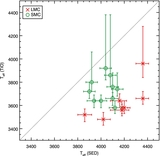The Temperatures of Red Supergiants
Abstract
We present a re-appraisal of the temperatures of red supergiants (RSGs) using their optical and near-infrared spectral energy distributions (SEDs). We have obtained data of a sample of RSGs in the Magellanic Clouds using VLT+XSHOOTER, and we fit MARCS model atmospheres to different regions of the spectra, deriving effective temperatures for each star from (1) the TiO bands, (2) line-free continuum regions of the SEDs, and (3) the integrated fluxes. We show that the temperatures derived from fits to the TiO bands are systematically lower than the other two methods by several hundred kelvin. The TiO fits also dramatically overpredict the flux in the near-IR, and imply extinctions which are anomalously low compared to neighboring stars. In contrast, the SED temperatures provide good fits to the fluxes at all wavelengths other than the TiO bands, are in agreement with the temperatures from the flux integration method, and imply extinctions consistent with nearby stars. After considering a number of ways to reconcile this discrepancy, we conclude that three-dimensional effects (i.e., granulation) are the most likely cause, as they affect the temperature structure in the upper layers where the TiO lines form. The continuum, however, which forms at much deeper layers, is apparently more robust to such effects. We therefore conclude that RSG temperatures are much warmer than previously thought. We discuss the implications of this result for stellar evolution and supernova progenitors, and provide relations to determine the bolometric luminosities of RSGs from single-band photometry.
- Publication:
-
The Astrophysical Journal
- Pub Date:
- April 2013
- DOI:
- 10.1088/0004-637X/767/1/3
- arXiv:
- arXiv:1302.2674
- Bibcode:
- 2013ApJ...767....3D
- Keywords:
-
- stars: atmospheres;
- stars: evolution;
- stars: fundamental parameters;
- stars: late-type;
- stars: massive;
- supergiants;
- Astrophysics - Solar and Stellar Astrophysics
- E-Print:
- 21 pages, 26 figures. Accepted for publication in ApJ
